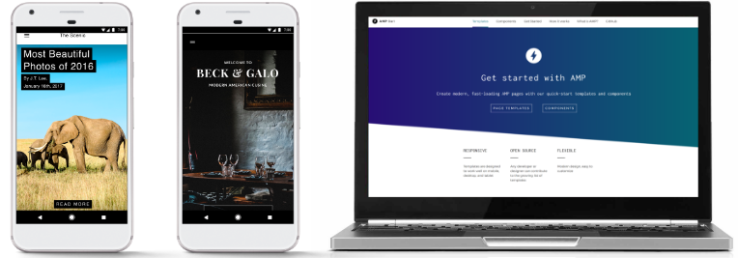

As Google looks for ways to keep people using its own mobile search to discover content — in competition with apps and other services like Facebook’s Instant Articles — the company is announcing some updates to AMP, its collaborative project to speed up mobile web pages.
Today at the Google I/O developer conference, Google announced that there are now over 2 billion AMP pages covering some 900,000 domains. These pages are also loading twice as fast as before via Google Search. Lastly, the AMP network is now expanding to more e-commerce sites and covering more ad formats.
The advances serve as a counterbalance to some of the controversy that Google and others have courted through initiatives like this, which are optimised for user experience, but have been criticised for pointing people essentially to Google/Facebook/other domains and therefore taking traffic away from the sites themselves.
In a blog post announcing the news — published on WordPress, possibly to underscore how Google is trying to show this off as a collaborative, cross-company initiative? — Google takes a page from the Amazon school of stats and declines to disclose what the actual page load time is now via Google Search for HTML pages encoded with AMP (short for accelerated mobile pages).
But it notes that the improvement comes from changes that have been made at the backend, specifically with the AMP Cache, reducing bandwidth for images by 50 percent; and implementing a new compression algorithm called Brotli that Google announced in 2015 that reduces document size by 10 percent.
The list of sites that support AMP, meanwhile, has now had a massive boost with some of the latest additions focusing on social networking.
Tumblr (which is owned by Yahoo, whose search engine points to AMP pages) is now pushing 340 million blogs and 500,000 domains to render in AMP on mobile. Twitter is also now linking to AMP pages in mobile web (when you click on links in Tweets), and plans to expand AMP links to its mobile apps soon.
In Asia, Tencent’s Qzone (the largest social network in China) and Weibo (the third largest) now also rendering mobile pages using AMP.
Now that Google has established the basics of how AMP works for a wide swathe of pages, it looks like it’s stepping up its commercial gears in AMP.
Specifically, it’s ramping up the number of e-commerce pages that are using the format, and it’s also expanding the number of ad units that AMP pages will support.
The e-commerce expansions include eBay, which first introduced AMP support on about 15 million pages about a year ago and is now expanding to “millions more” including all of its product pages with a specific focus on adding name-brands and “Interest” pages that aim to give users more targeted results rather than the hodge-podge that you might otherwise see on the site.
Others who are adding AMP include Zalando in Europe, Myntra in India, and AliExpress in China.
The ads initiative, meanwhile, applies much of the same principle as the general page-loading times to the concept of advertising. Specifically, today Google is introducing coding for three new ad formats:

This is significant because one main reason that pages have crept to a halt on the web is because of advertising and the large amount of bloatware that accompanies them to measure what we do.
It’s led many people to implement ad blockers or browsers like Opera that block ads for you.
For a company like Google, whose bread and butter is essentially online ads, this is an alarming trend, and so it’s no surprise at all that its efforts to improve the mobile user experience have moved into improving the mobile advertising user experience.
Of course, by writing the code for these new ad formats, it’s also putting itself in the middle of how those ads will be implemented, giving Google an ongoing place at the table for how the next generation of the mobile web will monetize.

